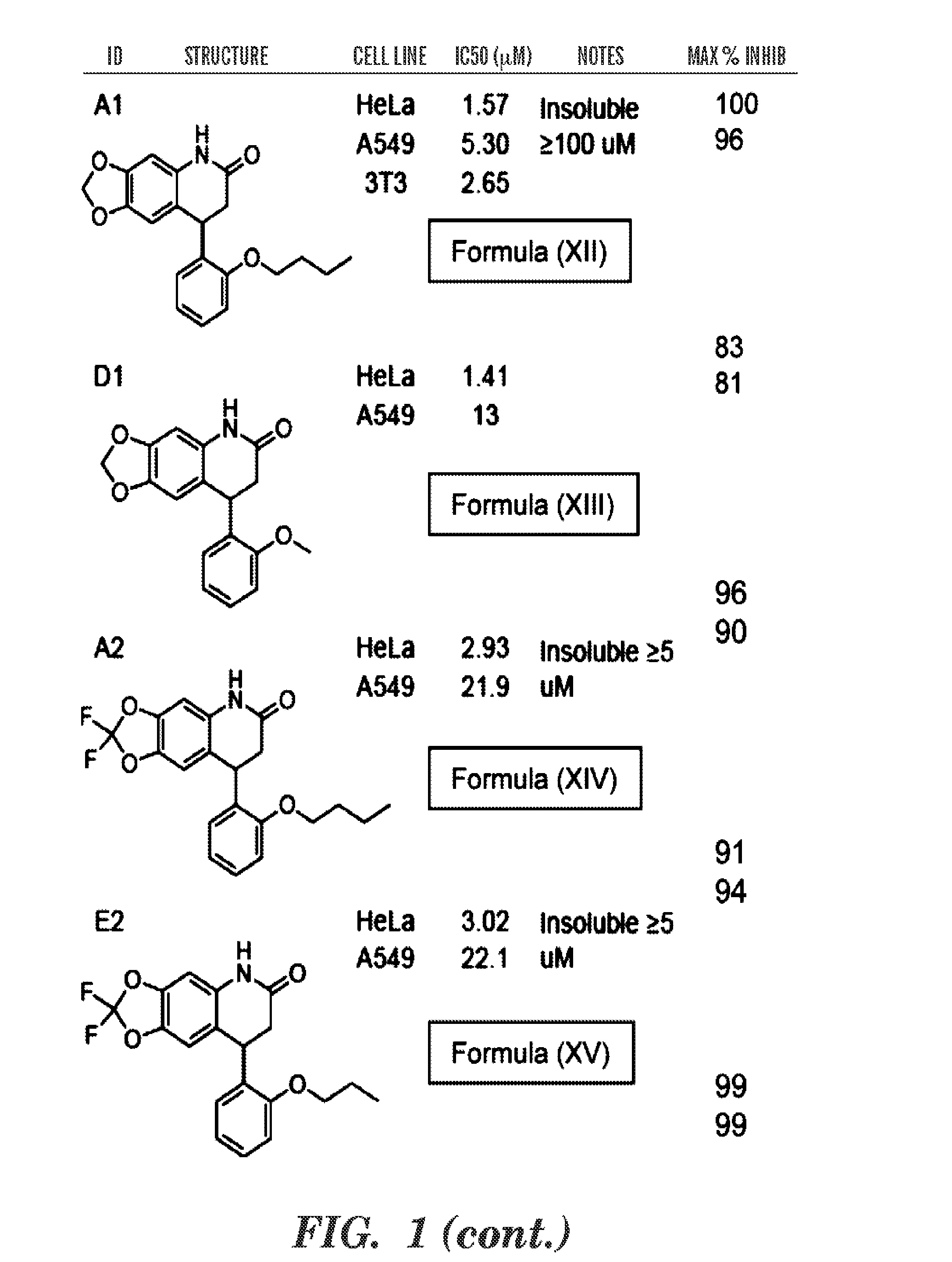Inhibitors of late sv40 factor (LSF) as cancer chemotherapeutics
a technology of sv40 factor and inhibitor, which is applied in the direction of biocide, heterocyclic compound active ingredients, drug compositions, etc., can solve the problems of insufficient irradiation and chemotherapy, the current treatment options of hcc are not optimal, and surgery is only appropriate for patients with small resectable tumors, etc., to achieve the effect of remarkable therapeutic benefits
- Summary
- Abstract
- Description
- Claims
- Application Information
AI Technical Summary
Benefits of technology
Problems solved by technology
Method used
Image
Examples
example 1
Identification of Small-Molecule LSF Inhibitors
[0297]The role of LSF in HCC (which is reported in Yoo et al., PNAS, 2010; 107; 8357-8362, which is incorporated herein in its entirety by reference) clearly demonstrates that LSF inhibitors are prime candidates for the treatment of hepatocellular carcinoma. Subsequent data suggest utility in other cancer indications, including but not limited to oligodendroglioma, meningioma, GBM, breast cancer, colon cancer, HNSCC, lung cancer (adrenocarcinomas and Small cell carcinomas), pancreas, ovary, thyroid, and undifferenated cells. In particular, the inventors demonstrate using an in vitro cell assay that the FQI1 and FQI2 compounds of Formulas (IV) and (V) respectively as disclosed herein can be used to inhibit the growth of a variety of cancers, as demonstrated from the Examples (see FIGS. 9 and 10). Accordingly, in some embodiments, a composition comprising any compound of formula (I) to (XXVI) can be used to inhibit the growth of a variety...
example 2
Antiproliferative Activities of Inhibiting LSF with FQI1 and FQI2
[0304]Given previous discussions that LSF activity is essential for G1 / S progression6,7, cell proliferation assays were conducted to characterize the antiproliferative properties of inhibiting LSF with the identified quinolinone inhibitors. The lead compound, FQI1 (formula IV), inhibited NIH 3T3 fibroblasts, HeLa S3 cells, and A549 cells at 50% inhibitory concentrations of 3.0, 0.79, and 6.3 μM (GI50's) respectively (Table 4).
TABLE 4Growth-inhibitory activities of FQIcompounds in different cell linesGI50 (μM)CompoundNIH / 3T3HeLaA549FQI1 (Formula IV)3.0 ± 0.850.79 ± 0.046.3 ± 1.1(R)-FQI1 (Formula (R)-IV)45 ± 7 8.0 ± 1.0 18 ± 3.2(S)-FQI1 (Formula (S)-IV)1.1 ± 0.410.30 ± 0.033.0 ± 1.3FQI2 (Formula V)0.71 ± 0.13 0.40 ± 0.041.9 ± 0.9
[0305]Consistent with the observations in the luciferase reporter assay, the (R)-enantiomer was almost 10 times less active, whereas the (S)-enantiomer was determined to be at least twice as acti...
example 3
Effect of FQI1 on Inhibition of HCC Cell Proliferation
[0308]The effect of LSF small molecule inhibitors on growth properties of HCC cells, in which LSF overexpression is oncogenic8, was assessed. Two cell lines were assayed: QGY-7703, an aggressive HCC cell line that expresses LSF at highly elevated levels, and HepG3, a non-tumorigenic cell line that expresses LSF only at moderate levels8. These cells were used in earlier Examples in demonstrating the oncogenic properties of LSF: expression of a dominant negative mutant of LSF in QGY-7703 cells is sufficient to reduce cell growth in vitro and in xenograft models, and expression of LSF in HepG3 cells is sufficient to enhance cell growth and induce tumorigenic ability in xenografts. In cell viability (MTT) assays, both FQI1 (Formula IV) and FQI2 (Formula V) decreased overall cellular proliferation of QGY-7703 cells (FIG. 4A). Subsequent studies performed by the inventors in collaboration with other scientists demonstrated similar grow...
PUM
| Property | Measurement | Unit |
|---|---|---|
| concentration | aaaaa | aaaaa |
| concentration | aaaaa | aaaaa |
| temperature | aaaaa | aaaaa |
Abstract
Description
Claims
Application Information
 Login to View More
Login to View More - R&D
- Intellectual Property
- Life Sciences
- Materials
- Tech Scout
- Unparalleled Data Quality
- Higher Quality Content
- 60% Fewer Hallucinations
Browse by: Latest US Patents, China's latest patents, Technical Efficacy Thesaurus, Application Domain, Technology Topic, Popular Technical Reports.
© 2025 PatSnap. All rights reserved.Legal|Privacy policy|Modern Slavery Act Transparency Statement|Sitemap|About US| Contact US: help@patsnap.com



